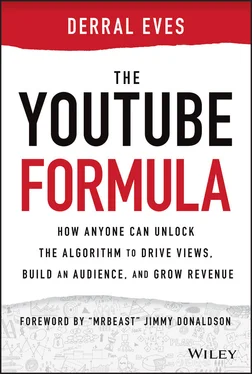Advertising companies could get into this market very inexpensively. They could track their market, get a lot of eyes on their product quickly without expensive campaigns, and they could do it for literally a fraction of traditional marketing cost. A lot of big brands and businesses gave it a snooty pass because they just didn't realize what they were missing in the beginning. They were too good for it.
One of my favorite examples of a YouTube advertising success story comes from a product called Orabrush. Orabrush is a tongue cleaner that was invented in the early 2000s by a guy named Robert Wagstaff, aka “Dr. Bob.” Dr. Bob had tried to market his tongue cleaner via traditional product‐pitching means, but the companies he approached wanted nothing to do with it. He even invested a lot of his personal money to run an infomercial. It flopped. So at the ripe old age of 75, Dr. Bob turned to a marketing class at his local university and asked if anybody had any bright ideas.
My good friend Jeffrey Harmon was a student in that class, and he told Dr. Bob that he thought they could sell the product online with a YouTube video. He took on the tongue cleaner project with the promise of Dr. Bob's personal motorcycle as payment for the campaign. Jeffrey and some creative friends made their YouTube video for just a few hundred dollars, and it went viral. People wanted to know where they could buy Orabrush in their own locations, and distributors started to pay attention.
An ad campaign like this had never been done on YouTube, but Jeffrey saw its potential. “We took a product from zero sales anywhere to worldwide distribution,” Jeffrey told me. “And we didn't do it with traditional marketing. It was 100% YouTube. We couldn't have made it happen any other way.” Orabrush became a multimillion‐dollar brand that is sold in more than two dozen countries in 30,000‐plus stores.
For the record, Orabrush's YouTube channel has more than 38 million video views to date. For a tongue brush. Orabrush was acquired by DenTek in 2015.
YouTube leveled the playing field for a small‐town, old‐man inventor and a few college kids. They had access to the market that was simply unavailable to regular people before YouTube. It literally changed the trajectory of their lives. Jeffrey Harmon became cofounder and chief marketing officer at Orabrush and has gone on to cofound the Harmon Brothers marketing agency with his three brothers, where they have created extremely successful online campaigns for PooPourri, Squatty Potty, Purple, Lume, and many more businesses. Others who worked on the original campaign also have made successful careers out of the path that was set from Orabrush's beginning.
Another friend of mine, Shay Carl Butler, began his YouTube career way back in 2006 and was one of the original Partners, so if anyone has a good handle on how the program began and how it has changed ever since, it would be him. “The YouTube Partner Program was so exciting in the beginning, and everyone who knew about it wanted a piece,” Shay Carl said. “YouTube had a lot of problems to work out. I remember when it seemed like everybody was mad at some point: viewers were mad at creators, creators were mad at creators, viewers and creators were mad at YouTube, and so on. But YouTube has done a good job overall of working out the kinks.” Shay Carl's personal channel is where he began in 2006, but he started his family channel, Shaytards , in 2008, and it has become the main YouTube lifeline for his family with around five million subscribers to date. We'll go into more detail about the Partner Program in Chapter 6.
Because of this “digital gold rush” and the amount of creators and advertisers it brought in, YouTube was not equipped to respond to the masses. This is where the multichannel networks came in. MCNs offered to be the go‐between for other contributors in the YouTube ecosystem in exchange for a piece of the profit. They helped creators and businesses with audience growth, resources for production, and brand opportunities. They matched advertisers with channels that suited their particular products or services. They dealt with rights management. They gave YouTube some breathing room to worry about other things. MCNs have had both good press and bad, but they did alleviate a lot of YouTube's headaches in those formative years of ad revenue sharing.
I recently sat down with Jim Louderback, CEO of VidCon and former CEO of MCN company Revision3, and talked with him about multichannel networks on my podcast Creative Disruption. He talked about how MCNs affected the early years of YouTube's ad revenue explosion. We discussed the ways they helped, but also the problems they created. “In the end,” said Jim, “a lot of MCNs did not provide the value they offered. They brought on too many creators and brands to manage, and there wasn't enough revenue to go around.”
Once YouTube had a better handle on operations, they offered their own Partner support rather than losing creators to outside MCNs. In 2011, YouTube acquired Next New Networks, a company that had been managing a lot of YouTube's early creators. YouTube was ready to take back control internally and put that money back into their own pocket. For this reason and others—like fewer creators signing up, and a smaller margin of revenue per view—MCNs have seen a significant decline on YouTube in recent years.
An Evolving, Thriving System
As you can see, ad revenue sharing completely changed the YouTube ecosystem. YouTube had been a minefield of instability in its fledgling years. They were learning the hard way that their ecosystem was a delicate balancing act—among its copyright holders, its viewers, its Partners, and its advertisers. There has been an “Adpocalypse,” countless issues with the algorithm, FTC COPPA children's privacy issues, Adpocalypse 2.0, and more. YouTube has learned to deal with the problems and tried to make changes to satisfy the masses, but it is a constant effort.
When we come full circle back to the viewer, the first component in the ecosystem, we have to consider how much the viewer has changed. YouTube really wants to have satisfied viewers. Over the years, they have tried to modify their recommendation feature to figure out exactly what each viewer might want to watch. They know that happy viewers will stay around longer, and viewers who stay around longer will produce happy content creators and happy advertisers. And the more the viewers watch, the more money everybody makes. The thousands of changes that have been made to the algorithm over the years have literally paid off, so the better the algorithm gets, the happier everyone will be. Get ready to dive deep into the algorithm in the next chapters.
YouTube must be figuring out some things, though, because they have seen 31% year‐over‐year growth! In 2020, YouTube announced their revenue for the first time ever. In 2019, they made $15.15 billion, which was nearly double the year before! That is mind‐blowing, in both the amount of money and the percentage of growth. People watch more than five billion YouTube videos a day. Billion . To really grasp how much bigger a billion is than a million, consider this: one million seconds is roughly 11 days, while one billion seconds is 31½ years . Now give a second thought to that $15.15 billion figure for YouTube's 2019 revenue, and gasp. And they are really only just getting started.
YouTube began as a dating website for a handful of college co‐eds in California in 2005. Now it reaches every corner of the globe on every device. Roughly one‐third of the entire population of the earth is watching YouTube regularly. Again, we are talking in billions. Where it used to be a specific demographic, the YouTube viewer is now everyone .
Читать дальше












